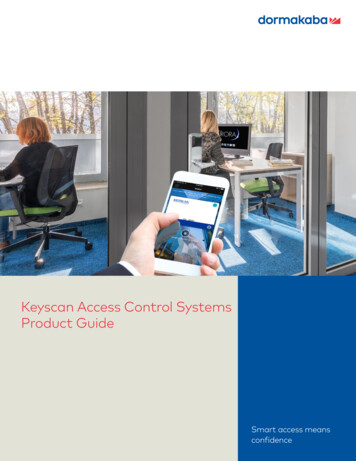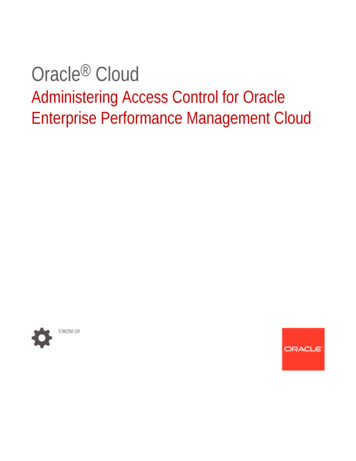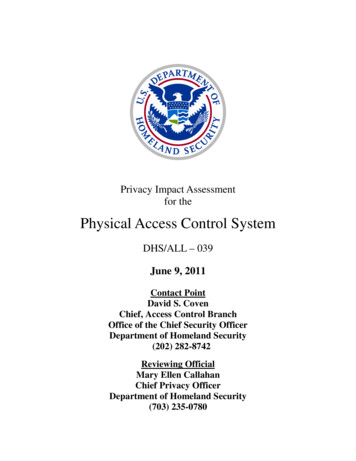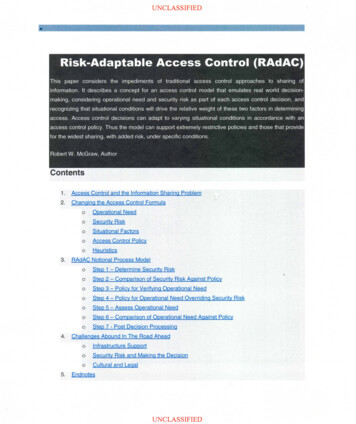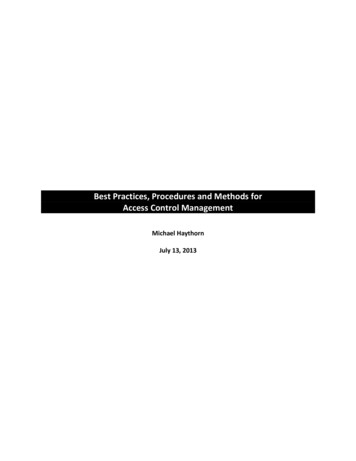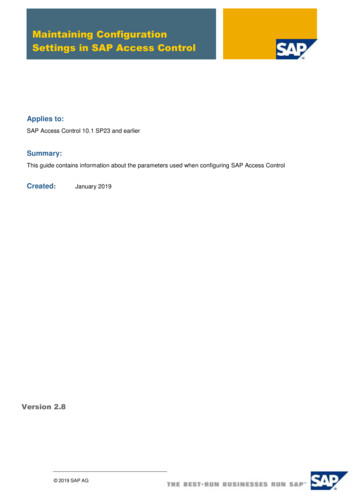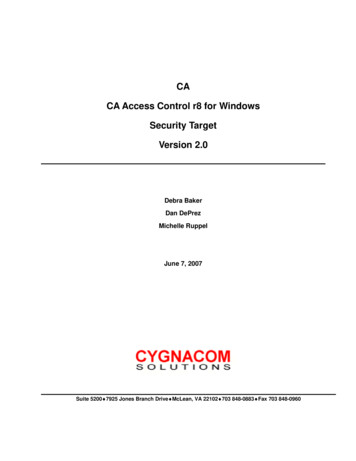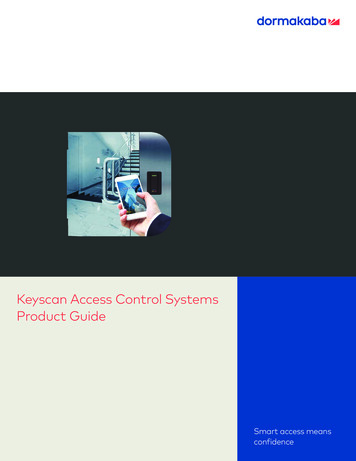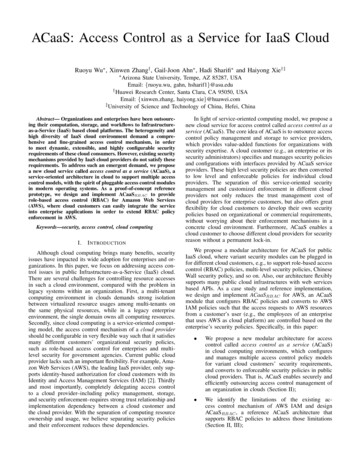
Transcription
ACaaS: Access Control as a Service for IaaS CloudRuoyu Wu , Xinwen Zhang† , Gail-Joon Ahn , Hadi Sharifi and Haiyong Xie†‡ ArizonaState University, Tempe, AZ 85287, USAEmail: {ruoyu.wu, gahn, hsharif1}@asu.edu† Huawei Research Center, Santa Clara, CA 95050, USAEmail: {xinwen.zhang, haiyong.xie}@huawei.com‡ University of Science and Technology of China, Hefei, ChinaAbstract— Organizations and enterprises have been outsourcing their computation, storage, and workflows to Infrastructureas-a-Service (IaaS) based cloud platforms. The heterogeneity andhigh diversity of IaaS cloud environment demand a comprehensive and fine-grained access control mechanism, in orderto meet dynamic, extensible, and highly configurable securityrequirements of these cloud consumers. However, existing securitymechanisms provided by IaaS cloud providers do not satisfy theserequirements. To address such an emergent demand, we proposea new cloud service called access control as a service (ACaaS), aservice-oriented architecture in cloud to support multiple accesscontrol models, with the spirit of pluggable access control modulesin modern operating systems. As a proof-of-concept referenceprototype, we design and implement ACaaSRBAC to providerole-based access control (RBAC) for Amazon Web Services(AWS), where cloud customers can easily integrate the serviceinto enterprise applications in order to extend RBAC policyenforcement in AWS.Keywords—security, access control, cloud computingI.I NTRODUCTIONAlthough cloud computing brings many benefits, securityissues have impacted its wide adoption for enterprises and organizations. In this paper, we focus on addressing access control issues in public Infrastructure-as-a-Service (IaaS) cloud.There are several challenges for controlling resource accessesin such a cloud environment, compared with the problem inlegacy systems within an organization. First, a multi-tenantcomputing environment in clouds demands strong isolationbetween virtualized resource usages among multi-tenants onthe same physical resources, while in a legacy enterpriseenvironment, the single domain owns all computing resources.Secondly, since cloud computing is a service-oriented computing model, the access control mechanism of a cloud providershould be configurable in very flexible way such that it satisfiesmany different customers’ organizational security policies,such as role-based access control for enterprises and multilevel security for government agencies. Current public cloudprovider lacks such an important flexibility. For example, Amazon Web Services (AWS), the leading IaaS provider, only supports identity-based authorization for cloud customers with itsIdentity and Access Management Services (IAM) [2]. Thirdlyand most importantly, completely delegating access controlto a cloud provider–including policy management, storage,and security enforcement–requires strong trust relationship andimplementation dependency between a cloud customer andthe cloud provider. With the separation of computing resourceownership and usage, we believe separating security policiesand their enforcement reduces these dependencies.In light of service-oriented computing model, we propose anew cloud service for access control called access control as aservice (ACaaS). The core idea of ACaaS is to outsource accesscontrol policy management and storage to service providers,which provides value-added functions for organizations withsecurity expertise. A cloud customer (e.g., an enterprise or itssecurity administrators) specifies and manages security policiesand configurations with interfaces provided by ACaaS serviceproviders. These high level security policies are then convertedto low level and enforceable policies for individual cloudproviders. The separation of this service-oriented securitymanagement and customized enforcement in different cloudproviders not only reduces the trust management cost ofcloud providers for enterprise customers, but also offers greatflexibility for cloud customers to develop their own securitypolicies based on organizational or commercial requirements,without worrying about their enforcement mechanisms in aconcrete cloud environment. Furthermore, ACaaS enables acloud customer to choose different cloud providers for securityreason without a permanent lock-in.We propose a modular architecture for ACaaS for publicIaaS cloud, where variant security modules can be plugged infor different cloud customers, e.g., to support role-based accesscontrol (RBAC) policies, multi-level security policies, ChineseWall security policy, and so on. Also, our architecture flexiblysupports many public cloud infrastructures with web servicesbased APIs. As a case study and reference implementation,we design and implement ACaaSRBAC for AWS, an ACaaSmodule that configures RBAC policies and converts to AWSIAM policies such that the access requests to AWS resourcesfrom a customer’s user (e.g., the employees of an enterprisethat uses AWS as cloud platform) are controlled based on theenterprise’s security policies. Specifically, in this paper: We propose a new modular architecture for accesscontrol called access control as a service (ACaaS)in cloud computing environments, which configuresand manages multiple access control policy modelsfor variant cloud customers’ security requirements,and converts to enforceable security policies in publiccloud providers. That is, ACaaS enables securely andefficiently outsourcing access control management ofan organization in clouds (Section II); We identify the limitations of the existing access control mechanism of AWS IAM and designACaaSRBAC , a reference ACaaS architecture thatsupports RBAC policies to address those limitations(Section II, III);
Fig. 2: Example AWS IAM policy.Fig. 1: ACaaS vs. security modules in operating system. We implement a prototype system, and provide webbased an administrative tool and web services APIsfor third party applications’ integration (Section IV).II.AC AA SFORC LOUDS(IAM) [2] which enables an organization to securely controlusers’ access to the AWS services and resources subscribedby the organization. IAM defines security policies with a setof pre-defined components which consists of following components: Users, Groups, Actions, Objects, Permissions, Constraints, User-Group-Assignment (UGA), Permission-UserAssignment (PUA), and Permission-Group-Assignment (PGA).Permissions are defined in the form of Actions on Objectsunder certain Constraints.A. OverviewSecurely maintaining valuable digital assets in clouds iscritical for both cloud service providers and customers. Thediversity of cloud services across a wide range of organizations and domains requires various security requirements.Accordingly, a comprehensive and adaptive access controlmechanism needs to be in place to support various securitypolicy models for the diverse security needs. However, currentcloud computing platforms such as AWS, Windows Azure,Google App Engine, and Eucalyptus all fail to meet suchidentified needs. Towards this, we propose the concept ofaccess control as a service (ACaaS) with the spirit of pluggableaccess control modules in modern operating systems. Asshown in Figure 1, we draw an analogy between computing, storage, network, and other resources provided by IaaSproviders and hardware resources in physical machines suchas CPU, disk, and network stack. Cloud provider offerings canbe mapped to operating system services such as process management, memory management, scheduling, I/O operations,and networking. For instance, process management conductsbasic tasks including starting and suspending processes, CPUallocation, and scheduling for multiple processes. Similarly,computing services in a cloud handle booting and terminatingvirtual machines instances, allocating resources, and scheduling computing tasks and workflows. For security purposes,authorization modules and policies in traditional operatingsystems (e.g., Linux) can be dynamically loaded (e.g., SELinuxmodules), and every access to underlying resources from processes and applications is then be controlled. Similarly, ACaaScan load different access control modules and support varioussecurity policy models for different cloud customers, suchas mandatory access control (MAC) [11], the Chinese Wallsecurity policy (CW) [3], and role based access control [12].This plug & play fashion enables parallel evolution of cloudcustomer’s own policy specifications and a cloud provider’ssecurity enforcement mechanisms.B. AWS Access Control Service and Its LimitationsTo motivate the design and development of ACaaS, weanalyze the access control mechanism in Amazon AWS cloudplatform - a service called Identity and Access ManagementBased on the above-mentioned IAM components, an IAMpolicy statement can be formally defined as a 4-tuple P (user, permission, constraint, effect),where effect can be Allow or Deny. An IAM policycan contain several IAM policy statements. For example,an IAM policy in JSON format with two policy statementsis shown in Figure 2. The user or group that the policy isattached to is not explicitly shown in the policy statements,who can be any user or group within the root AWS accountwith ID 123456789012. The root AWS account user canexplicitly assign this policy to his users or groups. This policyauthorizes users to perform the following tasks: (i) Createand list the access keys for any user in the AWS account,starting on July 1, 2010; and (ii) Create and delete AmazonSimpleDB domains in the 123456789012 AWS account forany region.AWS IAM enables cloud customers to manage users anduser permissions to secure their resources in clouds. However,we identify several limitations of IAM for enterprise cloudcustomers as follows:1)2)3)IAM directly assigns permissions to users. Withincreasing outsourcing computing infrastructures toIaaS, the number of users and permissions can bequite dynamic and in a very large scale. The management cost for the mapping between users andpermissions can be extremely high.IAM supports groups to categorize users and let usersexplicitly obtain permissions assigned to groups theybelong to. However, groups are organized in a flatstructure, which cannot reflect the hierarchical structures of organizations. For example, a global salesdepartment of a multinational company should haveall the permissions of its regional sales departments.Besides, if an IAM policy is removed from a group,the permission associated with the policy is revokedas well, which is not necessary in many cases.IAM allows to specify static constraints on permissions. However, it lacks a systematic support formany other important constraints such as separationof duty (SoD), a well-known principle for preventing
4)5)the potential fraud. SoD divides the responsibilityof a critical task into different people. When manyfinancial and governmental systems are shifting intocloud platforms, SoD issues become even more critical. If permissions with conflict-of-interest issues areassigned to the same user, many valuable assets inclouds can be jeopardized.Session management is missing in IAM such thatall permissions of users are effective all the times,which conflicts with the principle of least privilege.Users should be able to manage their sessions for performing tasks. Besides, without session management,dynamic SoD cannot be enforced.IAM does not distinguish administrators and regularusers clearly. The root user with the AWS account hasboth administrative and regular permissions, whichalso conflicts with the principle of least privilege.Ideally, permissions associated with an AWS accountshould be split into multiple units.AWS recently released a new IAM role feature, whichenables an EC2 instance running with a predefined IAM roleto securely access other AWS service APIs [1]. However, thisfeature is still too preliminary and coarse-grained to addressthese limitations. First, it only supports assigning IAM rolesto an EC2 instance level but not to user level. Hence, allapplications running in an EC2 instance assume the same setof permissions. This violates the least privilege principle, sinceit is very general that different applications in an EC2 instancerun on behalf of different users to have different permissions.Second, an IAM role does not support session managementsuch that an EC2 instance can only run with a single IAMrole. Without re-launching the EC2 instance, it is impossibleto switch between different IAM roles during the runtime.Furthermore, EC2 role does not support other important RBACfeatures such as role hierarchy and delegation. Fundamentally,we claim that the EC2 role is more similar to the traditionalconcept of “group” in access control and there is no RBACmodel formulated in AWS.III.D ESIGN OF AC AA SRBACFORAWSIn this section, we present the design of ACaaSRBAC ,a reference architecture of ACaaS that supports RBAC forAmazon AWS cloud platform. There are several reasons thatwe choose to support RBAC for AWS cloud platform. First,RBAC has been widely adopted in enterprise applications.When those applications are moving to clouds, RBAC shouldbe naturally supported in cloud environments. According to arecent cloud market overview [13], RBAC is one of the keycriteria to evaluate cloud computing solutions. Second, RBACis a very generic access control model, and we believe tacklingRBAC in clouds requires to address many challenges that willbe identically addressed for supporting other access controlmodels with ACaaS.A. Challenges of Supporting RBAC for AWSIn order to provide RBAC as a service for AWS cloudplatform, there are several critical challenges:Challenge 1: Efficient role hierarchy management. In cloudcomputing environments, due to dynamic business needs andFig. 3: ACaaSRBAC system architecture for AWS.scalable resource provisioning, the number of roles in anorganization could be very large and fluctuated frequently.Accordingly, role hierarchies in the organization could becomplex and need to be updated. It is crucial to have anefficient way to manage role hierarchies in terms of bothmaintenance and update/change management.Challenge 2: Session management. Session managementshould be supported to track users’ interactions and meetthe least privilege principle. Users should be able to activateor deactivate their roles for performing certain tasks in theirsessions. With the nature of highly distributed service-orientedcomputing infrastructure, ACaaSRBAC has to seamlessly support session management without compromising the securityproperty of RBAC.Challenge 3: SoD support and management of privilegedaccount. SoD constraints should be specified by administratorsand each cloud should be able to enforce those constraintsfor avoiding permission abuse and unexpected fraud. Thesuper user of an AWS account has all privileges upon cloudresources, which should be split into different units or roles inACaaSRBAC .Challenge 4: System integration and minimal overhead.To leverage the pluggable capabilities provided by ACaaS,ACaaSRBAC services should be easily integrated with customers’ applications. Besides, this integration should introduceacceptable performance and network traffic overheads betweencustomers’ applications and AWS cloud platform.B. System DesignOur design of ACaaSRBAC addresses all identifiedchallenges III-A with a service-oriented RBAC for AWScloud resources. Figure 3 shows the system architecture ofACaaSRBAC . In current AWS platform, enterprise applicationsare able to access cloud resources on behalf of enterprise users,where the AWS IAM enforces security policies defined byenterprise administrators. ACaaSRBAC introduces RBAC as aservice (RaaS), which is an RBAC module designed based onNIST RBAC standard [7] and can be hosted by AWS or anythird party service provider. This module supports and enforcesRBAC configurations by leveraging Amazon IAM service forenterprise administrators. It also provides session capabilityfor enterprise users, e.g., a user or an application can activateand deactivate roles within a single session when accessingresources in AWS 1 .1 We note that an RBAC session here is usually different from that in AWSservices, e.g., a DynamoDB session, although they can be co-related in animplementation.
RaaS provides browser interfaces for enterprise administrators and users to configure RBAC policies. In our prototype(cf. Section IV), RBAC policies are implemented as relationaldatabase entries. RaaS also provides web services APIs suchthat operations can be integrated into administrative tools orapplications from the enterprise side. The results of theseconfigurations are IAM policies that are pushed back to AWS,so that any further access from enterprise applications willbe controlled by these policies. Since IAM does not supportRBAC, RaaS transforms all role-based policies of a user intoAWS permission based policies which can be understandableand enforceable by IAM. The transformation process is togenerate direct relationships between users and permissionsby removing the role notion between them in the role-basedpolicies. For an enterprise that already has AWS resources inactive use, RaaS provisions the information of users, groups,permissions, objects, and actions from AWS via IAM APIs.RaaS contains eight sub-modules: Organization, User,Group, Role, Permission, Session, Constraint and Policy, eachof which is exposed as web services. The Organization submodule manages (e.g., list, register, and delete) organizationsto support the multi-tenant feature of ACaaSRBAC . The Groupsub-module manages user groups of a single organization foradministrative users, where the user information is provisionedfrom the organization’s AWS account. The Permission submodule manages the permissions of ACaaSRBAC . There aretwo types of permissions: user permissions (P) which areinherited from existing AWS permissions, and administrativepermissions (AP), which are effective for RaaS only. ThePermission sub-module maintains both P and AP, and managestheir assignment relations with roles. We elaborate the designof sub-modules in the rest of this section.1) User and Permission: This sub-module provides management on regular users (U), administrative users (AU), andpermissions (P), and provides interfaces and APIs to create,delete, activate, and deactivate U, AU, and P, and manage theirgroup memberships and role memberships. In RaaS design,both regular users and permissions are provisioned from AWSdirectly, with the credentials of the AWS account, which isusually the user who can create other users and policies inIAM. Therefore, RaaS does not store any information for Uand P.Administrative users can be further categorized into twotypes: root administrative users and regular administrativeusers. Root administrative users are able to add and deleteregular administrative users, and manage their permissions.Regular administrative users are able to perform certain administrative actions (ACTA ) on administrative resources (RESA )based on their administrative role memberships. By default, aroot administrative user is the AWS user that owns the IAMaccount. With the interfaces provided by RaaS, this user canfurther create regular administrative users and roles, and theiradministrative scopes. By controlling the user-role assignmentsto regular users and administrative users, RaaS can supportflexible policies such as splitting privileged accounts, andseparation of duty constraints.2) Role: This sub-module creates and deletes roles (R) andadministrative roles (AR), and most importantly, it managesrole hierarchies (RH). RaaS distinguishes R and AR such thatmandatory security policies can be enforced, e.g., by onlyAlgorithm 9ComputeActivatePermissions(u, ra ) PInput: A user u wants to activate a role raOutput: A permission set P, of which corresponding IAM policies need to beenforcedP, Pall ;ris getImmediateSeniorRole(ra );if hasRole(u, ris ) TRUE AND active(u, ris ) T RU E thenreturn ;elseComputeP(u, ra );foreach p P ermissions(ra ) doif p / Pall thenadd p into P;endendreturn P;endComputeP(User u, Role ra )begin R getSiblingRoles(ra )getImmediateJuniorRoles(ra );if R then return;else foreach r R doif active(u, r) T RU E thenforeach p P ermissions(r) doif p / Pall thenadd p into Pall ;endendelseComputeP(u, r);endendendassigning necessary regular roles to regular users. For leastprivilege purposes, RaaS may introduce many primitive regularroles, each of which is assigned with atomic permissions. Thisusually introduces large number of regular roles in a system,where role hierarchy becomes necessary.Towards efficient role-related operations, we adopt theNested Set Model [9] for role hierarchy in our implementation,which assigns left and right values to represent a scope of eachrole in a role hierarchy. If the scope of a role is inside the scopeof another role, it means the former role is junior to the latterrole. A big advantage of Nested Set Model for managing rolehierarchies is that only one entry for each role needs to bemaintained in the database. This avoids storing a lot of redundant role relationship information to maintain role hierarchies.It is also easy to update role hierarchies by updating associatedroles’ left and right values. One limitation of our current designis that, the Nested Set Model only supports to represent limitedrole hierarchies in a simple tree structure, i.e., one of tworole hierarchies based on NIST RBAC standard [7]. As ourfuture work, we would extend our implementation towardsmore general role hierarchy management.3) Session: This module provides session managementincluding role activation and deactivation for regular users.Usually, a user can be assigned with several roles at the sametime. In a session, to meet the least privilege principle, onlysome of those roles which are needed to perform a certaintask should be activated. After finishing this task, relevantactivated roles can be deactivated. When activating a role,permissions associated with that role should be effective byenforcing corresponding Amazon IAM policies such that usersare able to access cloud resources with needed permissions.An intuitive way for deactivating a role and activatinganother role is to remove all permissions of the original role
for the user in IAM, and then create new permissions andpolicies, and push all new policies to IAM. This is the approachwe adopt if these two roles have no overlapped permissions.With the existence of role hierarchy, it may not be necessary togenerate and enforce Amazon IAM policies for all permissionsof the new role since some permissions may have alreadybeen effective, e.g., these two roles have common inheritedpermissions from role hierarchy.To improve the efficiency of role activation and minimizethe communication overheads between RaaS module and AWScloud platform, we implement an efficient role activationalgorithm to compute a minimum permission set when activating a role, as shown in Algorithm 1. This algorithmworks as follows: if a user u owns an immediate senior andactivated role to role ra which needs to be activated, anempty permission set is returned and no policy needs to begenerated and enforced by Amazon IAM. Otherwise, For eachsibling role and immediate junior role to role ra , their seniormost and activated junior roles are identified recursively and acorresponding permission set Pall is constructed. Then for eachpermission associated with the role ra , if it does not belongto Pall , then it will be added to the returned permission set.On the other hand, when deactivating roles, the deactivationshould not affect functionalities of other activated roles whenthey have overlapped permissions.Correspondingly, we implement a role deactivation algorithm, as shown in Algorithm 2. The algorithm works asfollows: if any senior role to a role rd which needs to bedeactivated is activated, an empty permission set is returnedand no policy needs to be generated and enforced by AmazonIAM. Otherwise if role rd does not have any activated siblingroles, a permission set containing all permissions associatedwith the role rd is returned. Otherwise, a permission set Pallcontaining all permissions associated with activated siblingroles of the role rd is constructed. Then for each permissionassociated with the role rd , if it does not belong to Pall , it isadded into the returned permission set.4) Constraint: This sub-module provides constraints management services including creating, deleting, updating staticconstraints as well as separation of duty constraints. Staticconstraints are specified on permissions in existing AmazonIAM constraints format discussed in Section II-B and enforcedby IAM. Only when the static constraints are satisfied, usersare able to perform corresponding permissions. When creatingan SoD constraint, a set of potential conflicting roles and acardinality value need to be specified. The cardinality valueis a threshold of the total role occurrence in the potentialconflicting role set. When it is reached, IAM security policy ofthe user will be updated and any corresponding request willbe denied. SoD constraints are enforced by Constraint submodule itself when administrative users assign users to roles,or users activate their roles. Those static constraints are thenconverted into IAM policies and pushed into AWS.Dynamic separation of duty (DSoD) constraints are usuallyenforced during runtime, e.g., conflicting roles cannot beactivated in a single session. Similar constraints can be definedand checked by the session module.5) Policy: This sub-module provides Amazon IAM policygeneration and pushing services to ensure RBAC configura-Algorithm 9ComputeDeactivatePermissions(u, rd ) PInput: A user u wants to deactivate a role rdOutput: A permission set P, of which corresponding IAM policies need to beenforcedP, Pall ;Rsenior getSeniorRoles(rd );if Rsenior ̸ thenforeach r Rsenior doif active(u, r) T RU E thenreturn ;endendendRsibling getActivatedSiblingRoles(rd );if Rsibling thenreturn P ermissions(rd );elseforeach r Rsibling doif active(u, r) T RU E thenforeach p P ermissions(r) doif p / Pall thenadd p into Pall ;endendendendforeach p P ermissions(rd ) doif p / Pall thenadd p into P;endendreturn P;endtions of an enterprise can be reflected in AWS cloud platform.For example, when a user activates or deactivates roles, corresponding Amazon IAM policies are generated and pushedto the Amazon IAM policy engine for the enforcement. Morespecifically, for each permission in the permission set computed by Algorithm 1 or Algorithm 2, a corresponding IAMpolicy is constructed and sent to IAM for the enforcement. Policy transformation and deployment are also triggered by otheradministration actions that change the regular permissions ofa user.We note that our policy transformation is both completeand sound. That is, each state of the RaaS (the ACaaSRBACrelationships stored in its local database) can be translated to aset of IAM policies, e.g., each regular user has an IAM policy.This is due to the fact that both the users and permissionsare provisioned from AWS directly. For each RaaS state, thenet result of its configuration is a set of permissions that areauthorized for a user, after revolving the constraints such asSoD and DSoD. Similarly, each translation corresponds to avalid IAM policy since the permissions are defined with validresource names and actions defined by AWS.IV.I MPLEMENTATIONBased on our design, we have implemented a prototypesystem to provide RBAC services in AWS cloud platformthrough a web browser interface as well as web services. Thecore services of the system are implemented in Java basedon AWS SDK 1.3.0 and exposed as SOAP-based web servicesusing GlassFish Metro 2.2. A web-based management interfaceis developed by using JavaServer Pages (JSP) and MySQLCommunity Server 5.1. Both administrative users and normalusers can log into the interface with their usernames andpasswords. Administration tools can interact with the system
by calling the SOAP-based web services APIs where the bodyof messages are signed with pre-shared secret keys.All entities of the major components in ACaaSRBACare stored in tables of a relational database, which jointlyrepresents the state of the RaaS system. The name spacesof permissions, which are built on resources in AWS, areprovisioned through AWS APIs. An administrative operationresults in calling one or more AWS APIs, e.g., to create a user,a group, a permission, or add or remove an IAM policy in theroot user’s AWS account.In our future work, we will conduct case studies to illustratehow services provided by ACaaSRBAC can be utilized byexisting cloud applications, and evaluated our ACaaSRBACsystem in terms metrics such as efficiency and scalability.VI.C ONCLUSION AND F UTURE W ORKWe articulate the critical need of a comprehensive andfine-grained access control mechanism to meet dynamic, configurable, and extensible security requirements in public IaaScloud computing environments. To accommodate this need, wepropose a new modular architecture towards access controlas a service (ACaaS) for supporting multiple access controlmodels. As a reference implementation, we design and implement ACaaSRBAC , a service architecture that supports configurations of RBAC as a service for Amazon Web Services.For future work, we would evaluate our system with realworld datasets. In addition, we would enhance our systemwith flexible delegation mechanisms and accommodate revocation requirements, and design a more generic architecture tosupport other access control policies such as multi-level andgeneral mandatory access control policies.ACKNOWLEDGEMENTV.R ELATED WORKThere are several authorization and access control solutionsin cloud computing. C
cloud customer to choose different cloud providers for security reason without a permanent lock-in. We propose a modular architecture for ACaaS for public IaaS cloud, where variant security modules can be plugged in for different cloud customers, e.g., to support role-based access control (RBAC) policies, multi-level security policies, Chinese

